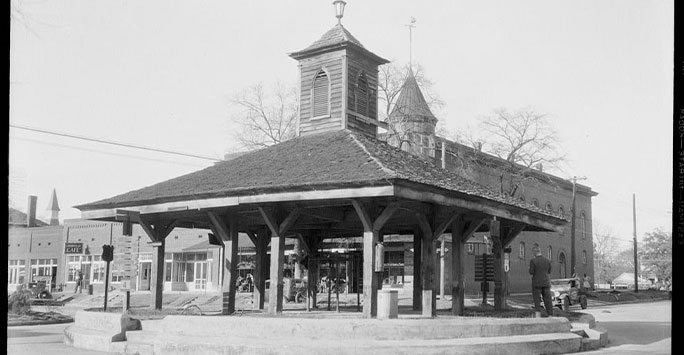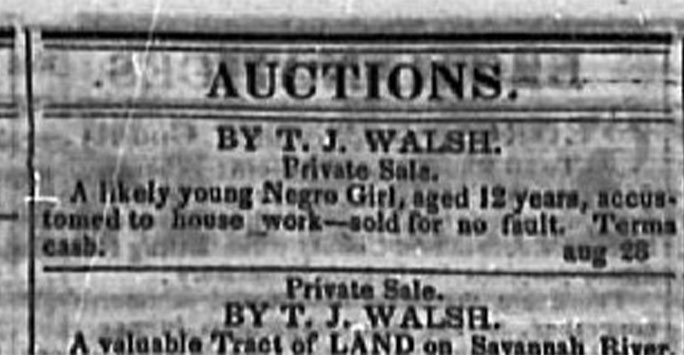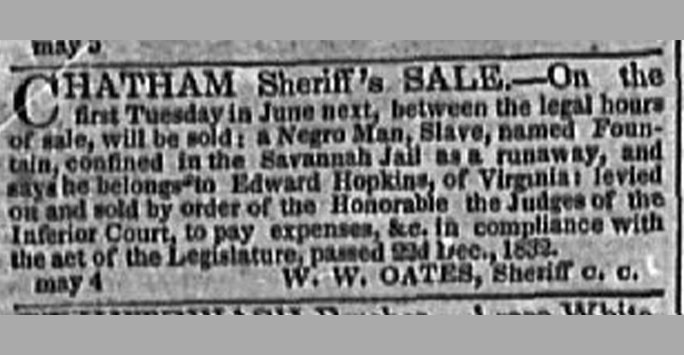
An image of a slave market in the public square of Louisville, Georgia. (Figure 1)
Slave Market, Public Square, Louisville, Jefferson County, GA, Library of Congress.
Many have seen British director Steve McQueen’s multi award-winning film, 12 Years A Slave (2013), based on the memoir of Solomon Northup. Northup was not alone in his experience, as vast numbers of American-born enslaved people were forcibly moved across America in the decades between 1790 and 1860. In his ground-breaking 1996 monograph, Speculators and Slaves, (and in his later work) the University of Liverpool historian Michael Tadman has estimated that well over one million people were bought and sold by professional slave traders and trafficked to the booming plantation areas within the southern states. Popular culture often recirculates the myth that slave trading occurred largely in Africa, or that the slave trader - allegedly a social outcast - completed his transactions hidden from public view. In reality, the buying and selling of human beings was widespread across American society. Nowhere else is this more apparent than in America’s historical newspapers, which contained daily advertisements for the sale of enslaved women, men and children. Investigating advertisements for the sale of enslaved people in US historical newspapers was the focus of the Graduate Research Internship Scheme we worked on over these past summer months; a project that reiterated the importance of raising awareness about the true scale of the American domestic slave trade.
McQueen’s 12 Years A Slave harrowingly depicts a young woman named Eliza, sold away from her two children at a public auction. These sales routinely took place in public spaces, and our search reveals they often occurred on courthouse steps in big cities, or on popular streets in thriving commercial sectors. [Figure One]. Enslaved people who were separated from their families by forced migration were still not safe; once bought, family ties remained at risk of being torn apart. Traders and slave owners focused on making profits by exploiting human beings, calculating the value of enslaved people in relation to their age, gender, colour, skills, height and weight – a crude assessment of human worth focused primarily on physical and reproductive capacity. The sense of disorientation, degrading treatment, and the exploitive labour that often followed in the continual drive for profit, undoubtedly had devastating effects on the mental and physical well-being of African Americans in the period. Slave auctions such as the one depicted onscreen in 12 Years A Slave, and the devastating consequences that followed were a lived reality for the overwhelming majority of enslaved Black people living in the US during the nineteenth century.

A newspaper clipping from the Savannah Daily Republican on the 28th August 1846. (Figure 2)
Savannah Daily Republican, 28th August 1846, 3.
Our comprehensive sampling of two southern newspapers, published in Alabama and Georgia, demonstrated both the scale of this domestic slave trade and the various types of sales. Newspaper adverts reveal the never-ending possibilities of families being torn apart by traders who saw Black people as commodities. For example, if an enslaved child hit puberty and was considered fit for work, they could be sold for a profit away from parents and siblings – advertisements in our search revealed children as young as twelve being sold alone. [Figure Two] Typically, enslaved African Americans lived without a sense of security. If an enslaver passed away and their estate was divided, or if the enslaver found themselves in debt, enslaved families were often disregarded in order to generate the most profit from sales. In 12 Years A Slave, Solomon Northup was able to regain his freedom, but it is important to recognize this was an atypical case. Northup had received an education and had wealthy friends to assist in his emancipation. Many African Americans did not have this privilege, and advertisements reveal that those attempting to escape the system by their own means, namely by running away, were often recaptured and sold back into slavery. [Figure Three]

A newspaper clipping from the Savannah Daily Republican from the 5th May 1849. (Figure 3)
Savannah Daily Republican, 5th May 1849, 3.
12 Years A Slave crucially makes the history of American slavery more widely known, and also brings to light the hardships and abuse faced by the majority of America’s enslaved population. However, the continued research of social historians is vital in allowing the public to gain an appreciation for the true scale of the domestic slave trade. The buying and selling of enslaved people involved an intricate web of both passive and active players throughout all sectors of American society. Advertisements for enslaved persons were placed by a diverse range of actors, including traders, sheriffs, and probate executors, meaning the trading of Black lives was much more widespread than is often recognized. Increasing public access to these types of historical sources will not only enable people to immerse themselves in Black history, but also allow family historians to conduct searches for their ancestors. This is especially important for the Black community who are still grappling with the legacies of the slave trade, as seen by recent protests in Louisville against an old slave market still present in the city. Society can learn from the past, but it begins with an increased awareness and knowledge surrounding these difficult histories.
Alice Fairclough and Alex Geddes both graduated in July 2022 with First Class degrees in History. Alice is now studying for an MA in the History of Medicine at The University of Warwick, while Alex has started an MSc in Marketing at the University of Liverpool’s Management School. Alex and Alice worked as researchers during the summer months on a pilot-study project exploring ‘advertisements for the sale of enslaved people in US historical newspapers’, which was part of the Faculty of Humanities and Social Sciences Graduate Internship Scheme.